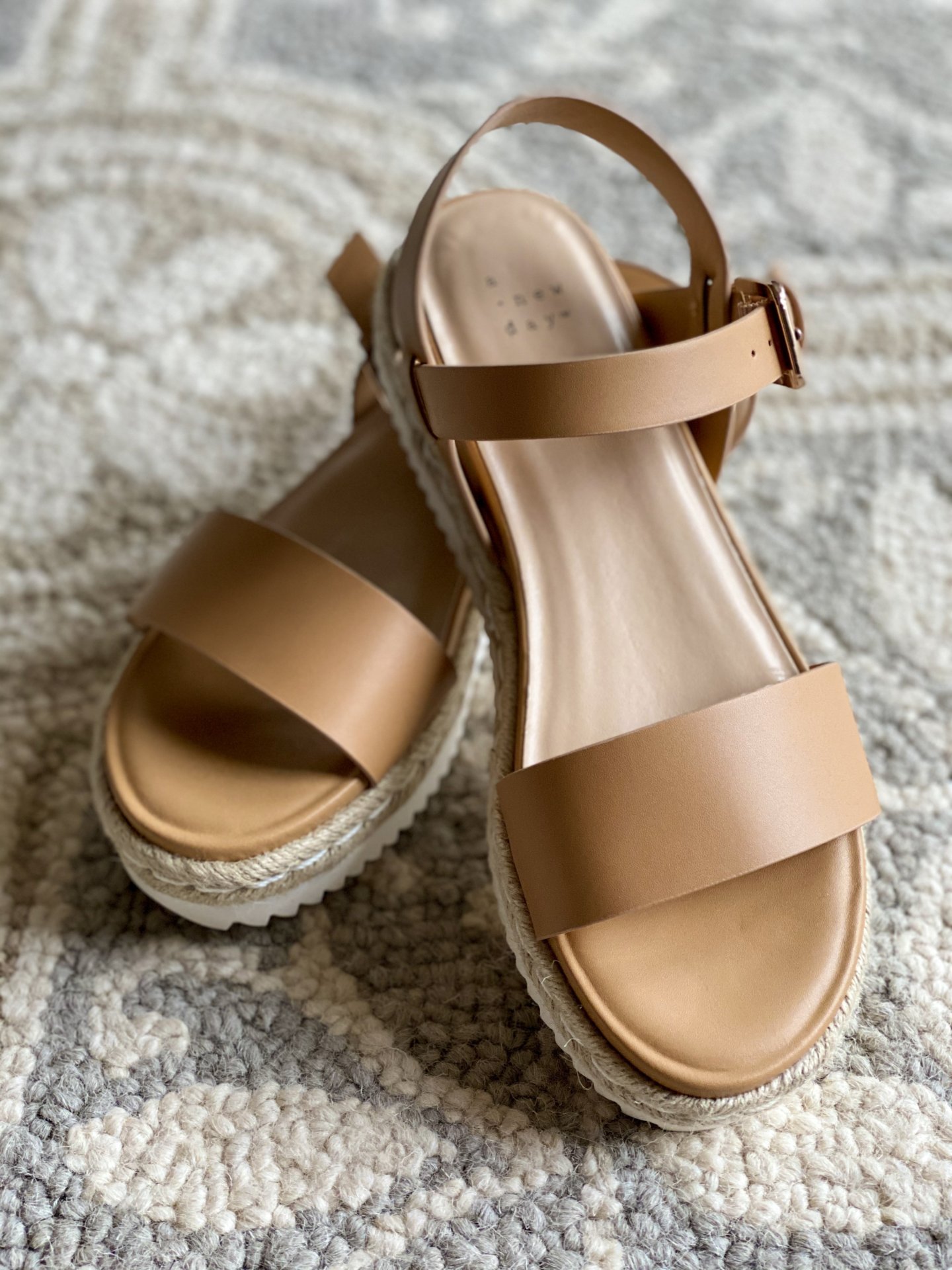
For Safe Manicures and Pedicures
A girl likes her nails done and with sandal season fast approaching nail salons are usually abuzz right about now. However, with the COVID-19 threat, it might be best to skip the salon (even when they open back up) and do at-home manicures and pedicures. But whether you’re doing at home nail care or are venturing back into the salon, using Disinfectable Manicure and Pedicure Tools is of the utmost importance in our current world health climate. This is a subject I might know a thing or two about and today I’m sharing my favorites.
When it Comes to Safe Manicures and Pedicures, I Have Street-Cred (and a license) 😉
I have been a licensed manicurist for almost 23 years and so it baffles me that in the four years I’ve been blogging I’ve never done a post on nail care. Not even polish recommendations! What’s wrong with me?
But in light of our current world health crisis and quarantine, I thought this would be a great time to talk about doing safe manicures and pedicures at home. And once the salons are opened back up or if you’re still brave enough to go into a salon (if they’re open) I want you to go in armed with some knowledge and some disinfectable manicure and pedicure tools. We’re starting the conversation on the subject of disinfection.
Specifically today, we’re covering:
- The Real Dirt on Hands and Nail Salons
- The Difference Between Sanitizing, Disinfecting, and Sterilizing.
- Why Salons Skimp on Sanitation
- My favorite disinfectable manicure and pedicure implements.
- What Sanitation Procedures Should You Look for at Your Salon
The Dirt Under Your Nails
I’m going to elaborate more on proper nail care in another post, but let me give you a preview: the nails free edge traps tons of dirt and bacteria and LONG NAILS HARBOR MORE BACTERIA than short nails. So right now in particular, keep those nails short and wash your hands good and often.
The nastiness the lurks under longer fingernails is also a reason to keep your children’s (or your elderly parents) nails trimmed short. I’ve seen my grandsons’ fingernails. It’s like a bad science experiment under there.
The Real Dirt on Nail Salons
The tissue surrounding the nails on our hands and feet is delicate and easily compromised making them easily susceptible to germs and bacteria. So getting the skinny on salons sanitizing and disinfectable manicure and pedicure tools are key to staying safe and healthy and still having good nails. I know these things are important to us.
Nail salons are some of the dirtiest places you can go to. They may not look like it on the surface but trust me, I’ve been to the larger ones, you know, the ones on every corner, and I’ve owned my own one-table studio.
Proper sanitation of tools, surfaces, the air, and equipment is expensive and costs time in an industry where time is money. In my salon, at my busiest, I maybe saw 6 – 8 clients a day and even then, giving tools the proper time to soak between clients or changing out the germicide solutions daily presented challenges. So imagine what these mass, walk-in salons skip in the sanitization even in non-pandemic times. Yuck!
LONG NAILS HARBOR MORE BACTERIA than short nails. So right now in particular, keep those nails short and wash your hands good and often.
Sanitize vs. Disinfect vs. Sterilize
It was drilled into us a beauty college that the salon industry can mostly only sanitize and disinfect our equipment unless we invest in expensive heat-sterilization equipment. But, what’s the difference between sanitizing, disinfecting and sterilizing? And what’s best for each surface and tool?
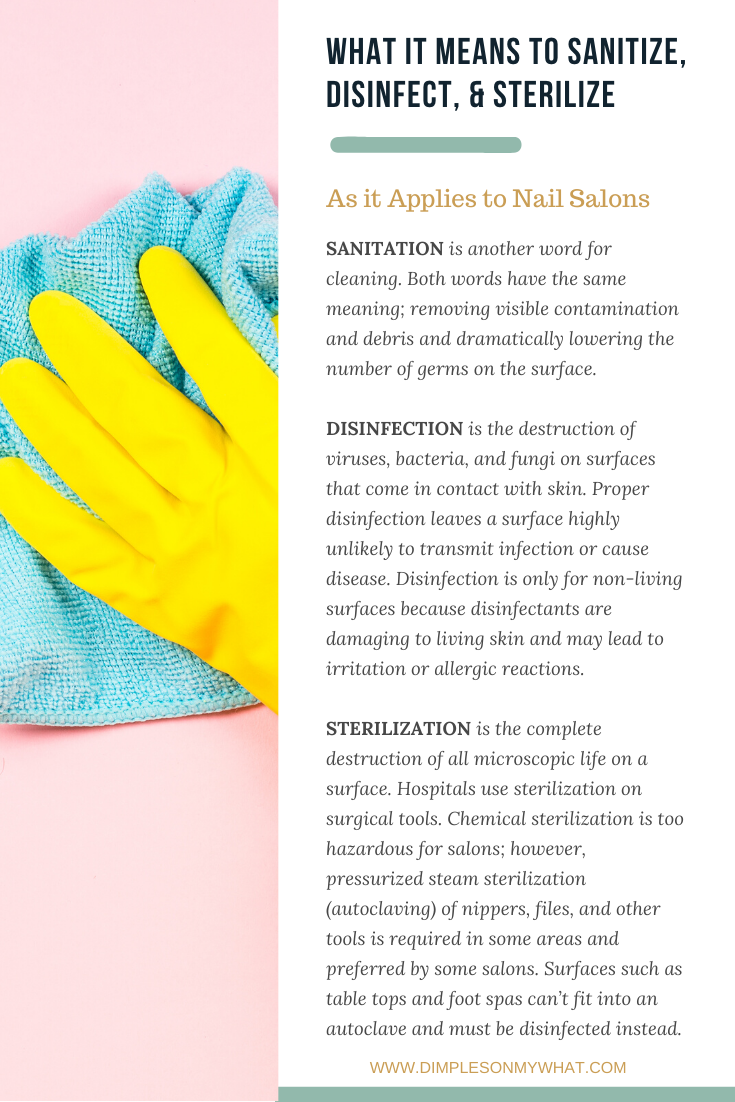
Why Salons Skimp on Sanitization
But, even if a salon has an autoclave heat sterilizer, the implements must first be washed (sanitized) then placed in a sealed packet and locked into the autoclave for a period of time. And of course, there’s a cooling-off period. Remember about time being money?
The salon would also have to have multiples of the sanitizable implements if they are running back to back clients and so you can see how this is getting pricey, especially for the small salon. But, that being said, cleaning and disinfecting are perfectly acceptable for nail care implements and equipment if it’s done properly or at all.
At this time I would hope that most nail salons have closed, at least for a short time. Because even if you and the manicurist wear a mask, they are likely touching your hand, feet, and nails with questionably clean implements.
But whether you’re doing your manicures and pedicures at home for now, or when you venture back into the salon, having tools that can be properly disinfected is a good investment for safe manicures and pedicures. And today I’m going to share some of the tried and true disinfectable manicure and pedicure tools I have used at home and in the salon for years.
I want you to be one of those weirdos who takes her own tools into the salon. If they don’t like it, leave and find another salon. Taking control of our health is worth any perceived judgment you face.
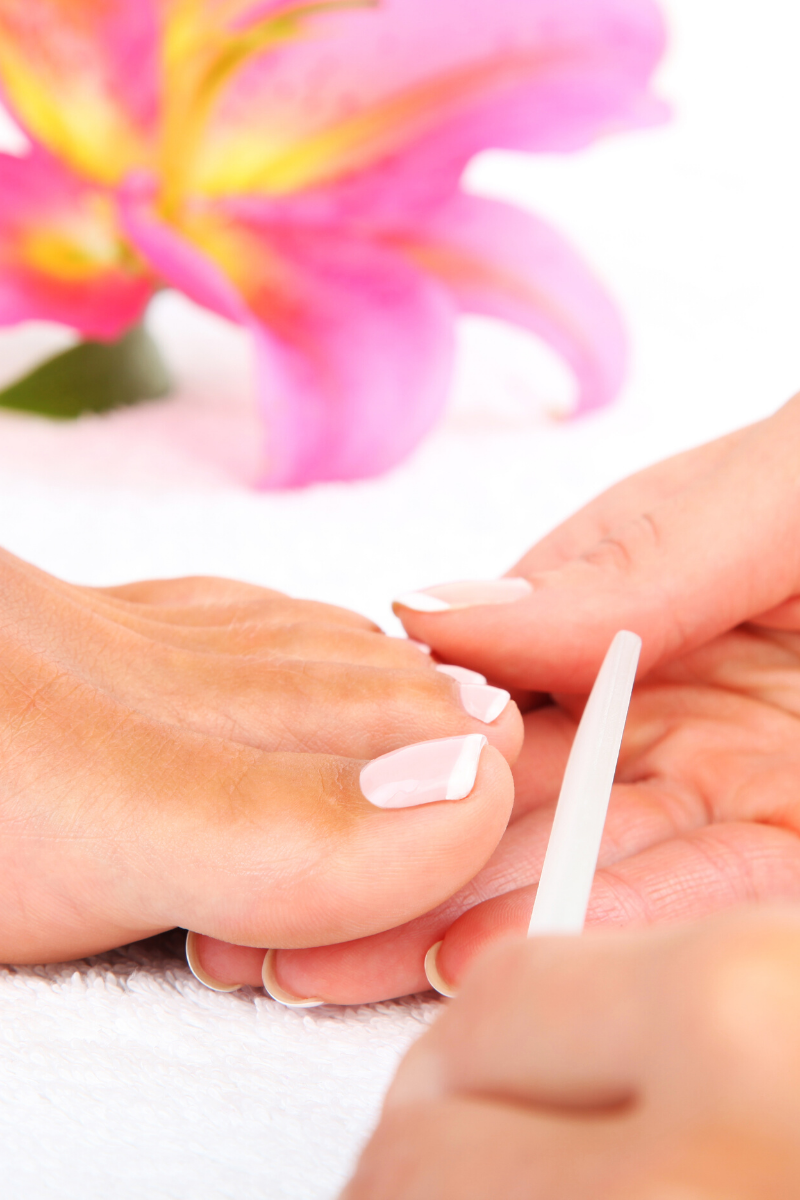
My Favorite Disinfectable Manicure and Pedicure Tools
Straight EdgeNail clippers – Most nail clippers are metal and can, therefore, be fully disinfected. The straight edge nail clipper is a lot easier to control which makes it less likely to cut yourself with.
Wide-Jaw Toenail Clippers – Okay, Cornchip Toe-nails require the big guns and a wider opening will make it easier to get at thick or just misshaped toenails. It’s all about ease and safety by reducing the risk of cutting yourself.
Nail Cleansing Brushes – You will need multiple nail brushes. Having one at each sink ensures you get those germs out from under your fingernails. But keep one brush specifically for cleaning your manicure and pedicure tools.
Cuticle pusher – Both plastic and metal cuticle pushers are able to be disinfected. I like either, but if you choose metal, BE CAREFUL. However, these pumice stone types of cuticle sticks are a great alternative, are very safe to use and can be scrubbed up quite nicely.
Nippers – If you use straight edge nail clippers you don’t necessarily need nippers because most hang-nails can be clipped with the straight-edge clippers. The nipper should be reserved for deeper hangnails and can even help you clip off sharp nail corners. (Almost never cut your cuticles.)
Foot files – Okay, there are abrasive foot files and buffers that can be cleaned properly, but these Diamancel foot files are my absolute have to have. I have the buffer and the #20 callus remover. I’ve probably had them for 15 or more years and they have been used for my clients and myself. They are highly effective and can be used on wet or dry feet. And there is no question of their ability to be disinfected. Honorable mention goes to these foot files. And if you’re looking for a quickie, I like battery devices power files sometimes. 😉
Nail files
Tropical Shine – There are other brands of emery-board style nail files that can be disinfected but I love Tropical Shine files and buffers and have used them in the salon for years. They are long-lasting too. Be gentle though and get a lower abrasive number as I have linked.
Soft/ Sponge File – I am not a fan of block files, as I think they are as controllable and the sharp edge can easily cut delicate tissue. But I do like a sponge file for buffing on top of the nail. We’ll cover the specifics in another post. I couldn’t find the ones I use so I linked some as part of this full set.
Crystal/ Glass – For the ultimate ability to disinfect a file, glass is the best choice. But they are best for natural nail and they create a really smooth edge.
How to Disinfect Abrasive Files, Sponge Files, Blocks, and Buffers
- Add a few drops of *antibacterial liquid soap/detergent to a clean and disinfected brush. (*General oap in general washes away bacteria for this step.)
- Under running water, gently scrub with a brush all surfaces to remove all visible debris and residue while thoroughly rinsing.
- After cleaning, disinfect by immersing in (or saturating with – by spraying) 70-90% isopropyl* or ethyl alcohol (or another germicide) for 5 minutes.
- Remove items, rinse thoroughly in running water. (Note – I don’t usually rinse them.)
- Allow them to air dry, completely.
What Sanitation Procedures Should You Look for in Your Nail Salon
Let’s be clear, the only way to be sure the manicure and pedicure tools used on you are clean, especially in high-traffic nail salons is to take your own. But if you can’t bring yourself to do that, here are a few things to look for to insure the safest possible nail service:
- Make sure any nippers, clippers, or other metal implements are put into a germicidal solution after they use them on you. That’s usually a greenish or bluish liquid in a glass container at their station. If they put them in after your service it’s more likely they came out of a disinfectant as well.
- If the manicurist picks up a dust-filled cup (that’s not dust, it’s skin and nail clippings) with tools in it and moved it to the next station, they aren’t intending to wash those. I’ve seen it happen with my own eyes!
- Pay attention to what’s going on around you. Are they cleaning surfaces between clients, taking care of the tools by either putting them in solutions or taking them out?
- Dust isn’t necessarily an indication of a dirty salon as it’s a work hazard. But if it looks as if it’s never been cleaned, I’d steer clear.
- Are those mass nail polish dryers wiped out after each use? I’ve never seen this happen in a salon where I’ve patronized.
- The cleaning of the Pedicure Basin is a big concern so much so it gets its own section.
Pedicure Basins are Particularly Concerning
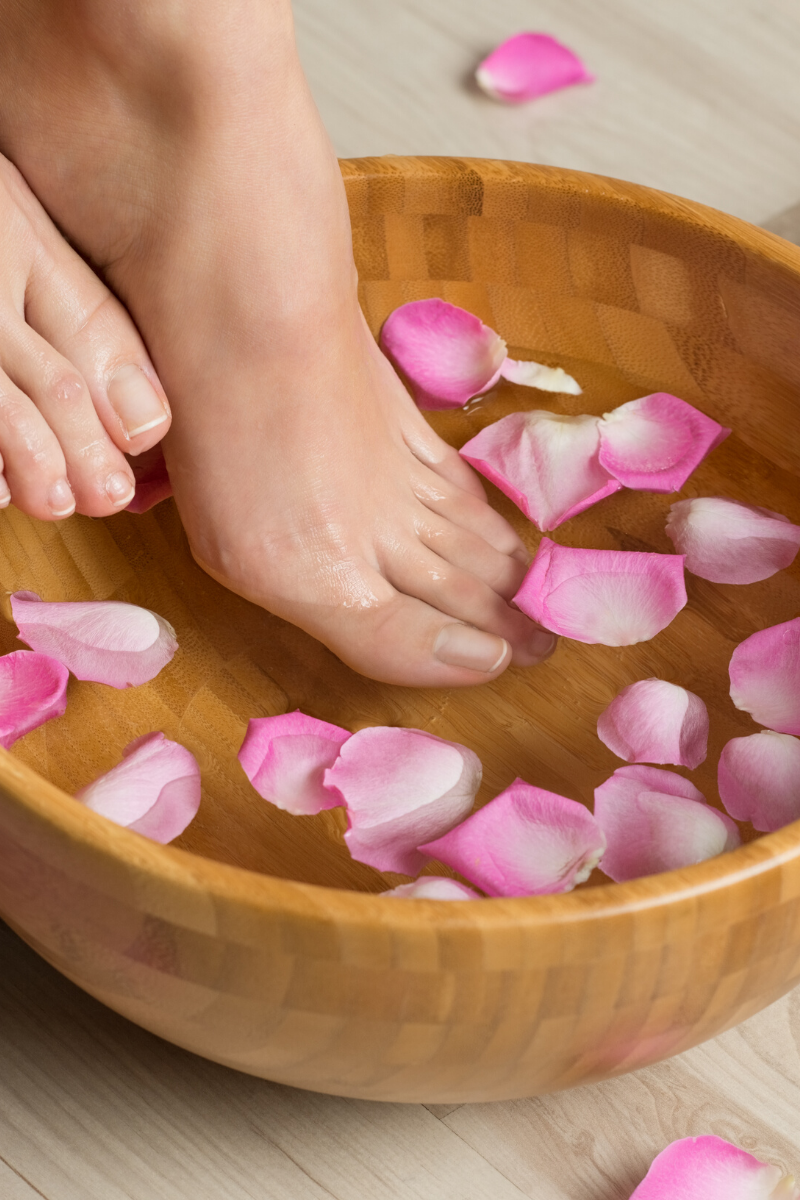
Oh, those beloved, relaxing jacuzzi pedicure basins. This could be an entire post on its own as dirty ones could lead to skin infections and worse.
Technically they are supposed to be emptied after each use, refilled with a disinfectant solution that should be run through those jets. The disinfectant solution should be allowed to sit in the jets for a bit before being emptied, then the tub gets refilled with clear water and rinsed through the system and emptied again. But this NEVER happens! Is it overkill? I don’t know.
But consider there’s more than dirty water that got pulled into the pipes of that jet system. Dead skin, nail clippings, and oils that create a film are sitting in there too. And you know what it’s like to scrub that scum off the side of the bathtub. Ick! It’s kind of like getting into a jacuzzi tub at a hotel. EEKS!
It’s Cool to be Safe
Our safest bet is to find a nice day-spa that uses cool pedicure basins without jets like the one in the photo above. For home pedicures, I have purchased extra-large salad bowls from TJ Maxx or Marshalls. There’s no need to spend a fortune here.
I was once blessed to go on a work retreat at Sundance Resorts in Utah and had a very zen pedicure experience. They used large clay basins to soak your feet during the process which are much easier to clean and disinfect.
You might also be interested in my repeat buy beauty products
If You Wanna Be Somebody, If You Wanna Go Somewhere (the Nail Salon), You Better Wake-Up and Pay Attention
I don’t mean to freak you out. There are times when I myself go to a nail salon. The old meno-pot makes doing home pedi’s more difficult. But right now especially, I urge you to use caution. Hand to hand contact, airborne epithelial matter, and bacteria-ridden surfaces are no joke.
In short, pay attention! Getting your nails done may seem like a great time to scroll on your phone but in all honestly, it’s best to watch what’s going on at your station as well as throughout the entire salon.
As I stated above, taking your own disinfectable manicure and pedicure tools to the salon lessens our risk of picking up germs or infections.
Want More Mani News?
If you’d like to see more about manicures, pedicures, and polishes and treatments, jot a note in the comments. Also, if you have any questions, hit me up, I’ll do my professional best to guide you toward great nails.
Stay Healthy and Safe My Friends!

Pin it…
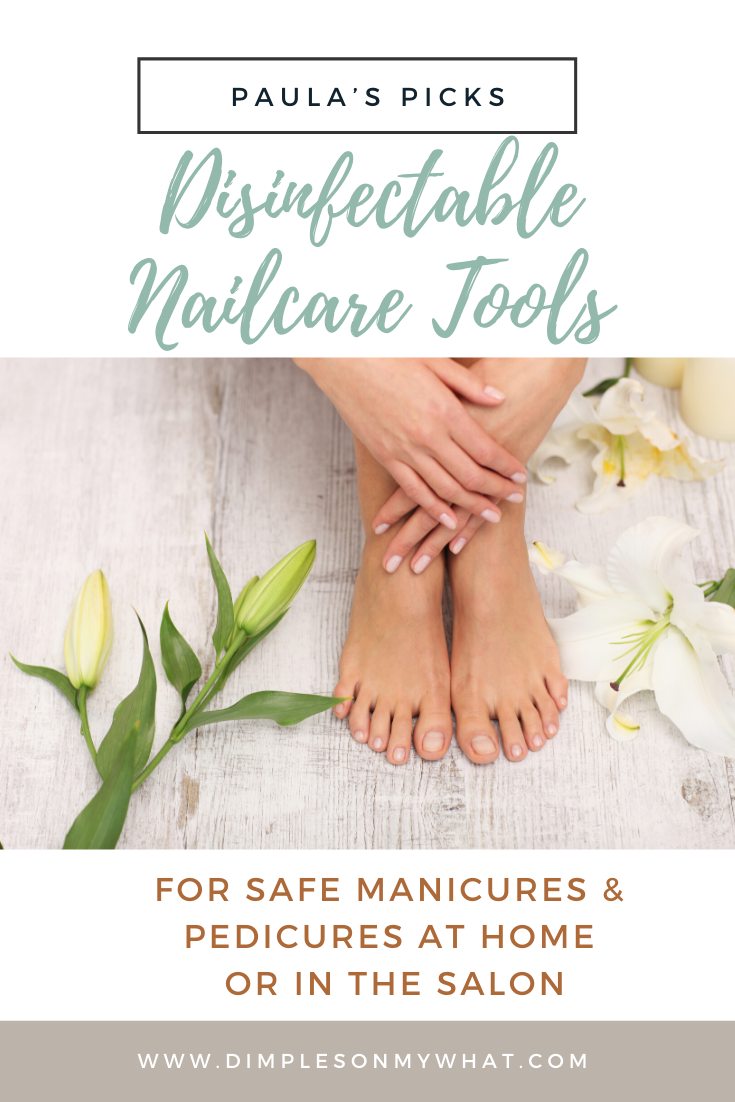

Ooohhh… good information!! Thanks!
I haven’t been to a nail salon in a long time. Previously, I had several CND shellac manicures. They were great until they weren’t! I am not sure if it is age or what, but now my nails are ridged and split and almost peel. Any suggestions on what I can do? Honestly, the condition of my nails does tend to bother me. Thanks for any words of wisdom.
Author
That’s a good way to put it about Shellac. The trouble with any “artificial” long term hybrid gel or polish product is that after a while, especially with the harsh removal process (acetone), your nails become dry, brittle, peeling and yes, sometimes ridgey. Overtime, 2.5mg of Biotin daily can increase the thickness of your nails by as much as 25%. It would be a step in the right right direction. Also moisturizing from the inside out helps too.
Hugs,
Paula
Well I had no idea you were trained for this. Thanks for all the tips. I do get my nails done regularly and I “think” my salon does a pretty good job of cleaning things…but who knows. Happy weekend Paula!!! XOXO
Paula, this post if super helpful! Love saying Nippers now. I have gone to a place that lines their basins with plastic and after soaking they empty and throw it away. Would that help with that part?
Author
The liners do help a lot if the it isn’t a recycling jacuzzi tub. The tribune with the recyclers is that water gets pulled in through the tubs and pushed back out. Then when those lines aren’t flushed out between clients it’s pushing a little water (and other stuff) from the previous client into you water.
The issue I’ve seen in general is tools used on me get out in a dry cup and moved to the next station. 😳
Stay well!
Paula
Interesting! I usually get my nails done about twice a year and was thinking of picking some polish next week and hope to do a decent paint job on my toesies!
http://www.chezmireillefashiontravelmom.com
Author
I’m like you Mireille, I only go to the salon occasionally and I need to work in my nails too. I don’t use polish on my fingernails much and generally I do without it on my ties during the winter. But sandal season is coming, even in Indiana. 😁
Hugs,
Paula
Oh wowzers! My sister and niece get mani and pedis done alot. They have attempted to get me to go but I see many of the things I suspected do happen. So gross. Do they get inspected like restaurants do? I’m immunosuppressed so if an infection got me, it could be really bad. You really got me with Cornchip Toenails. 🤣🤣🤣
Stay well!
Author
Ha! If you think about it: Feet and toenails aren’t as gross as hands, since we mostly know where feet go 😉. But seriously, I hear you, my mom is immune compromised right now because of long term chemo and she has lymphedema in her arm from mastectomy making her a higher risk for bad infections. If her infectious disease doc has told her not to get manicures & pedicures she won’t tell me. Because I’ve sure told her to steer clear.
Paula,
I had no idea that you were a licensed manicurist. The info you provided here is going to be a life saver. I’ve been going to the same nail tech in a small local shop in the Chicago area for several years. I was there every two weeks to re-do my gel nails. These cleaning details are so important to know and with this new info I’m going to bring in my own tools whenever I decide it is safe to return. Thank you so much!! I would like to get your thoughts on polishes – gel or otherwise.
Can you link a good tool disinfectant?
Author
Hello Brigette,
If you’re looking for a good disinfectant for home, I would use soap and water as suggested and then spritz with 70% isopropyl alcohol and let dry. There is also a product called Odoban that you can find in most cleaning isles now. It contains eucalyptus oil and kills 99.9% of bacteria.
Professionally, I used a product called Cavicide to clean surfaces and spray files and things after they were washed. And a product called Barbicide as a wet soak. There was another germicidal that was made for metal instruments as to not rust them but I can’t remember the name of it off the top of my head. But honestly, for home, I’d use alcohol.
Hope that helps,
Paula
I LOVE the idea of you doing more posts about nail care, nail color etc. It is an area that I don’t see much attention paid to on other blogs I read. Now having said that, I seldom do more than trim and buff my own nails but I can dream. My mother owned her own beauty shop in the 1940s and always kept her nails filed and polished even after marrying, being a farm wife and having 6 children. I didn’t inherit her long beautiful fingers or the patience to do it, however.